General
New Federal Gold Medal Match 224 Valkyrie Ammunition
I got a couple of boxes of the updated Federal Gold Medal Match 90 SMK ammo to the range today. I have NEVER been able to shoot well with the original offering of this ammunition from Federal, typically shooting 2″ to 3″ groups or worse, with the barrel seemingly spraying bullets everywhere. I ran my Bison Armory 24″ barrel with a Yankee Hill Resonator 30 cal silencer. I’m shooting at the 100 yard range at Clark Rifles near Vancouver Washington.
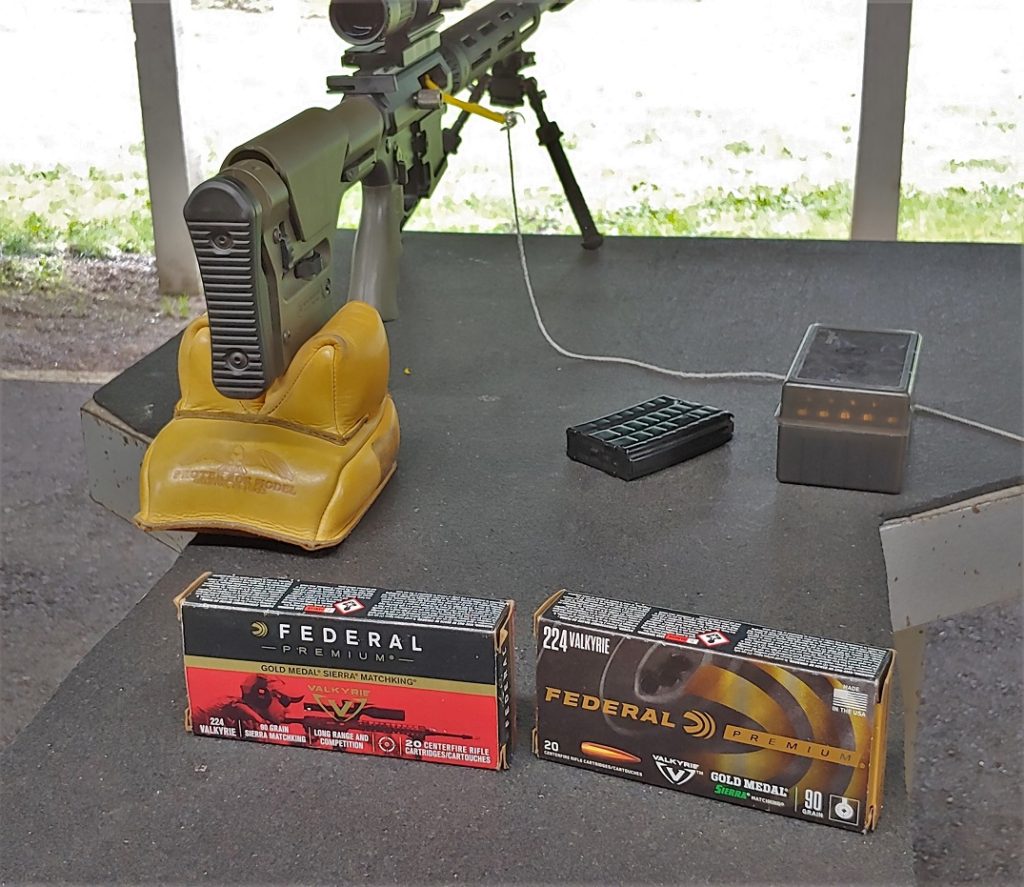
Old package on the left, new package on the right. I got the new ammo, in updated packaging, topped with the 90 SMK with the new thicker jackets and crossed my fingers. The results were excellent:

First two groups out of my rifle were five shots each of the FGMM loads, labelled as such on the target. Both came up 0.78 MOA. The ammo was running about 2650 and was surprisingly consistent in terms of velocity. I shot some of the old stuff, from a later batch therein, which ran a little over 2700 fps. Federal has backed off on the load a little as their earlier loads were way too hot. The old batch I ran I think was from a second run as it wasn’t as hot as the original stuff, and didn’t spray all over the place, but still only managed about 1.26 MOA, which is quite a bit better than what I’m used to.
I also got in a box of the new 90 SMK bullets from Sierra with the thicker jackets and loaded them up. I used an RCBS neck-bushing die to resize the once-fired Starline brass. I’m going to stick with the neck bushing die for loading this ammo from now on. First group out is at the bottom right, 5 shots into 0.48 MOA. These loads were light at 2590 fps or so, which stays above 1200 fps past 1100 yards. The light loads used 26.5 grains of Win 760 loaded to 2.290″ OAL. The next two loads shot nicely sub-MOA at 27.0 and 27.5 grains for 2650 and 2700 fps respectively. At 2700 fps these bullets are staying above 1200 fps to 1200 yards. I think this load, and the factory load, can shoot at 1000 yards out of a 20″ barrel with some legs to spare.
The two un-annotated groups are from my 22″ upper. The really poor group is one of my hand loads, and that barrel always shoots my SMK hand loads poorly. The smaller group that isn’t marked is the 90 SMK FGMM stuff, which shoots a lot better from this barrel than my hand loads. Go figure. That barrel has not impressed me and only really likes the 85 RDF for some reason. Still, keeping below 1.25 MOA consistently is good for that barrel.
I’m extremely pleased to see that Federal and Sierra have figured things out.
6.8 SPC Not So Special, eh?
On April 4, 2015, the Firearm Blog’s Nathaniel F Posted a very interesting article titled “Not So Special: A Critical View Of The 6.8mm SPC“. The article presents a critical review of the 6.8mm SPC cartridge and an extensive comparison with both typical and high performance .223 / 5.56 NATO ammunition. The results of the comparison indicate that the 6.8mm SPC cartridge cedes too much in terms of trajectory and velocity to modern offerings in 5.56 NATO to make up for what it gains in projectile energy at range. In summary, Nathaniel F finds that the 6.8mm SPC is useful for medium game hunting at modest ranges, and not much else.
At Bison Armory, we have a special affinity for the 6.8mm SPC cartridge, and so I have studied Nathaniel F’s article and I present here a critical response to his excellent and generally well considered article.
For the purposes of this review of Nathaniel F’s article, I will only consider factory ammunition and not hand loaded ammunition to simplify the discussion.
Historical Review
Nathaniel F’s article (I’ll refer to it going forward as “NFA”) begins with a brief history of the development of the 6.8mm SPC cartridge (6.8 SPC). This historical review is excellent and I have nothing more to write about it, except to say that if you are interested in the 6.8 SPC, this historical review, with links, is a good place to start.
6.8 SPC case geometry and projectiles
NFA provides good information regarding the case information including parent case, case taper, shoulder angle, case length, and case capacity. No quibbles here. NFA then mentions projectile selection:
It uses standard .277″ diameter projectiles, although it is limited in its selection of those by the overall length. In general, though the projectile diameter is the same, the 6.8mm Remington requires totally new projectiles versus existing .270 caliber rounds
This is not entirely true. Existing .270 caliber rounds, such as the 130 grain Berger VLD and 130 grain Woodleigh PPT are suitable for hand loading. But in general, this claim is fair.
Further:
It is very curious to me that a round that was designed with an accurized designated marksman’s rifle in mind also features such a short ogive and low muzzle velocity. Typically, medium/long range precision weapons platforms place a premium on both the ballistic coefficient and velocity of the projectile, seeking to obtain as laser-like a trajectory and as high a retention of energy as possible. The 6.8mm SPC runs directly counter to this.
And:
In light of this, the 6.8mm SPC’s maximum ogive length is the first curiosity of the cartridge’s design. With only 2.07 calibers available space for the ogive, the maximum ogive length for the 6.8 SPC is less even than that of the 5.56x45mm or 7.62x39mm cartridges.
Here’s where I begin to quibble with Nathaniel F’s piece. Does he mean the maximum length in terms of calibers or inches? The .223 Rem / 5.56 NATO has a 0.5″ of space available for the ogive, which is 2.23 calibers, while the 6.8 SPC has 0.574″ or 2.07 calibers. This presumes loading to SAAMI / NATO specifications which limit the OAL of both cartridges to 2.26″. Next:
This is very short for a rifle cartridge designed for maximum performance out to 450 meters, and limits the form factor of compatible secant-ogive projectiles to above 1.15 i7 (lower form factors yield higher ballistic coefficients), with tangent ogive projectiles having form factors as high as 1.32 i7. For comparison, the M855 projectile offers a 1.166 i7 form factor, despite not being particularly well streamlined. Finer projectiles compatible with the 5.56mm round offer i7 form factors as low as 1.09. Even when magazines allowing longer ogives are used – which it should be noted also would allow the use of longer and finer 5.56mm projectiles – the available relative space is still not significantly greater than that of the 5.56mm and 7.62x39mm cartridges. Further, as of yet there do not seem to be any manufacturers making .277″ projectiles with ogives designed for these longer magazines, and thus they only offer a velocity advantage to handloaders seating existing short-ogive bullets less deeply in the case.
This is a lot of blather. Form factor (or Coefficient of Form) is a very useful coefficient for describing the aerodynamic drag that acts on a bullet in flight, more useful in some ways than the ballistic coefficient. If you don’t understand the importance of form factor to ballistic performance, or how it relates to BC, I suggest a quick read of this article by Brian Litz at Berger Bullets. I think the previously quoted paragraph contains a lot of blather because statements like “This is very short for a rifle cartridge designed for maximum performance out to 450 meters,” are misleading. The idea of “maximum performance” is meaningless without providing a measure of optimality. This would in turn imply a cost function, and none is provided. This is unfortunate because the history of the 6.8 SPC provided near the beginning of the article clearly states the objectives of the cartridge program:
… to develop a new capability that would increase incapacitation, lethality, and range over the existing 5.45x39mm, PRC 5.8x39mm, 7.62x39mm and 5.56x45mm NATO cartridges.
…
Once all the performance data were compiled the team briefed the Commander on the results, and recommended that the 6.8mm [of the 6.5mm, 6.8mm, and 7mm projectiles considered to be combined with the 30 Rem parent case – ed.] provided the best overall terminal, reliability and accuracy performance out to 450 meters.
I don’t notice anywhere in the terse history provided in the article a requirement of a nebulous “maximum performance out to 450 yards.” I will put the actual statement of purpose to the test later on. So the loaded opening sentence about the purpose of the 6.8 SPC cartridge leads us into the rest of the paragraph which seems reasonable but is guilty of a serious error or omission of fact: The claim that projectiles for the 6.8 SPC are limited to form factors above 1.15 is simply false. This table summarizes form factors and ballistic coefficients for several 6.8 SPC specific projectiles and the 77 grain SMK for comparison:
Bullet Weight (gn) Diameter (in) SD G1 BC G7 BC i7
Sierra MatchKing 77 0.224 .219 .362 .185 1.184
Nosler Accubond 100 .277 .186 .323 .165 1.127
Nosler Accubond 110 .277 .205 .370 .191 1.073
Hornady BTHP 110 .277 .205 .360 .186 1.102
Sierra MatchKing 115 .277 .214 .324 .167 1.281
Hornady SST 120 .277 .223 .400 .207 1.077
77 grain SMK G1 = 0.362, G7 = 185, i7 = 1.184.
100 grain Nosler Accubond G1 = 0.323, G7 = 0.165, i7 = 1.127.
110 grain Nosler Accubond G1 = 0.370 , G7 = , i7 = 1.073.
110 grain Hornady BTHP G1 = 0.360, G7 = 0.186, i7 = 1.102.
115 SMK BTHP G1 = 0.324, G7 = 0.167, i7 = 1.281.
120 grain Hornady SST G1 = 0.400, G7 = 0.207, i7 = 1.077.
I don’t know where Nathanial F. got his data, but he needs to check his numbers. All of the above bullets were available and in use in commercially produced ammunition at the time of his writing from Silver State Armory, Hornady, and others.
Further, as of yet there do not seem to be any manufacturers making .277″ projectiles with ogives designed for these longer magazines, and thus they only offer a velocity advantage to handloaders seating existing short-ogive bullets less deeply in the case.
Several bullets are available that can be loaded to SAAMI case length or up to magazine length for the longer PRI, Magpul/LWRC, and C-Products magazines. Cavity Back Bullets has two different 120 grain bullets with high ballistic coefficients (.365 G1 hunting bullet and .400 G1 target/tactical bullet). The .400 G1 120 SST can be loaded long for increased muzzle velocity, as can the .370 G1 110 Accubond. Ammunition made with Berger 130 VLD bullets must be loaded to an OAL that requires the longer magazines. 120 to 130 grain bullets from Nosler, Cutting Edge Bullets, and others can be used as well.
Additional Metrics
The next few paragraphs find NF looking for any metric he can use to show that the 6.8 SPC doesn’t measure up to the 5.56×45 cartridge. Many of these numbers may be worth considering from a design point of view, but the 6.8 SPC is no longer in design phase; it is now an actual cartridge and there’s little point comparing design parameters when we can compare actual ballistics performance. Hence, I call foul.
I don’t plan to address the following information provided by NFA except to express my emotional displeasure with the topics:
Fineness ratio, bleh
Relative capacity, bleh
Powley computer bunk, bleh
The NFA article refers to MK262 running at 68kpsi, to which I says pardon? NFA refers to “more thermally stable propellants, but link is broken and what is he talking about? Another link to the material is here:
https://ndiastorage.blob.core.usgovcloudapi.net/ndia/2006/smallarms/faintich.pdf
Claims 2800fps from 18″ barrel, maybe on a hot day. Black Hills claims 2750fps and a recent trip to the range on a 50 F day found 2722 fps from an 18″ barrel and 2790 fps from a 20” barrel. So I find some exaggeration in the velocity claims made in the article.
NFA also makes up a metric called “internal specific energy” that is admittedly “not generally used in the relevant literature.” Bleh.
Bolt Thrust
NFA considers bolt thrust, because if he can find a problem with the 6.8 SPC he’s going to report it. He explains that the 5.56 NATO produces 5432 lbf bolt thrust while the 6.8 SPC produces 6537 lbf, and concludes:
The 6.8mm SPC round evidently puts much more stress on the rifle’s bolt than the 5.56mm round, which may cause the bolt to break sooner.
To which I reply: I’ve sold thousands of 6.8 SPC bolts, barrels, upper assemblies, and rifles, and I’ve yet to have a customer report a failure of a bolt that could be attributed to bolt thrust. Ugh. Again, real world vs design metrics crush his arguments. Naturally the 6.8 generates more bolt thrust than the .223 Rem because F = ma and K = 1/2mv2, , i.e. physics, and the 6.8 SPC has significantly higher kinetic energy at the muzzle than the 5.56 NATO. The question is really: “Can AR-15 bolts manage the bolt thrust associated with the higher power cartridge?” The data I have available replies with an incontrovertible “yes.” The consideration of bolt thrust is interesting but really results in little difference between the two cartridges.
External Ballistics
For a proper comparison of the performance of the 5.56 NATO with the 6.8mm SPC, external ballistics are where the rubber meets the road. NFA begins with a comparison of one of the lamest 6.8 bullets from a terminal performance point of view, the Sierra 115 MatchKing. This bullet is very stubby, has a low G7 BC, and high form factor. This was one of the earliest 6.8 SPC specific bullets and it shows. Comparing this bullet to the 77 grain .224 SMK in the MK262 may seem like apples to apples, but it really is not.
NFA also compares Hornady BTHP bullets, specifically the 75 grain .224 vs the 110 grain .277. In this case the 6.8 fares somewhat better but the results presented indicate little advantage in retained energy of the 6.8 at range, and inferior trajectory and velocity. NFA calls the 6.8 SPC performance “Lackluster,” but is it really? He gives the 110 grain Hornady BTHP a BC of 1.8 when 1.86 is probably more accurate. He increases the velocity of the 6.8mm Hornady round to 2660 fps while also increasing the velocity of the 75 grain Hornady BTHP to 2840 fps. I think he is giving preference to the 5.56 NATO numbers here and not being as objective as he could be. The 75 grain Hornady would produce about 2837 fps if we equate energy of the 77 SMK with the 75 BTHP. However, my range testing, along with the stated muzzle velocity for an 18″ barrel for the MK262 from Black hills, indicate that 2750 fps is more realistic. Hence, a more realistic value for the 75 BTHP is 2785 fps.
NFA external ballistics analysis included comparison of velocity, drop, and energy. To that I am adding optimal game weight (OGW), which is a dubious metric if used in isolation, for projectiles of dissimilar size (i.e. pellets vs baseballs), and without consideration for bullet construction and purpose. However, OGW for comparison of similarly constructed bullets in a range of calibers in which the smallest is not less than 70% of the largest (e.g. comparing .224 to .308).
The above numbers give the following ballistics (drop, velocity, energy) for the 4 rounds:
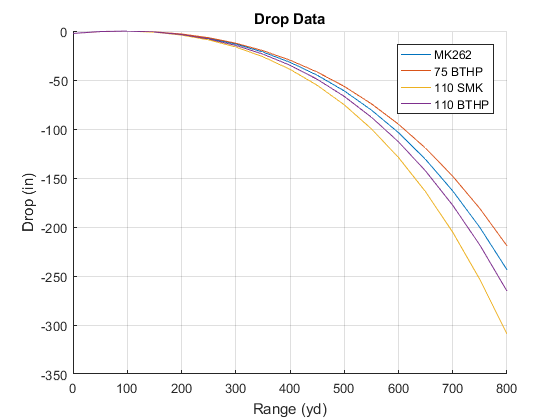
Drop data indicates the Hornady 75 grain BTHP loaded to the same energy as the MK262 is the best load considered. As range increases past 600 yards the 75 BTHP is dominant. The Sierra 115 grain MatchKing is a complete slouch and highly suboptimal. While an accurate bullet for shooting the 6.8 SPC out to 300 yards, it doesn’t have much purpose beyond this use. The 110 grain Hornady BTHP is vastly superior to the 115 SMK beyond 300 yards.
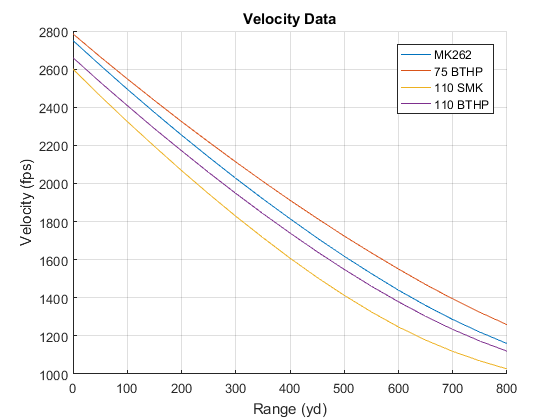 Velocity data is even more stark than the drop data. The disparities at the muzzle carry to all ranges, with the 75 BTHP blowing all challengers away. The 110 BTHP catches up to the MK262 with the 77 grain SMK. In this case the 110 BTHP stays above what NFA calls the transonic limit of 1300 fps past 750 yards while the MK262 achieves only about 680 yards with this distinction.
Velocity data is even more stark than the drop data. The disparities at the muzzle carry to all ranges, with the 75 BTHP blowing all challengers away. The 110 BTHP catches up to the MK262 with the 77 grain SMK. In this case the 110 BTHP stays above what NFA calls the transonic limit of 1300 fps past 750 yards while the MK262 achieves only about 680 yards with this distinction.
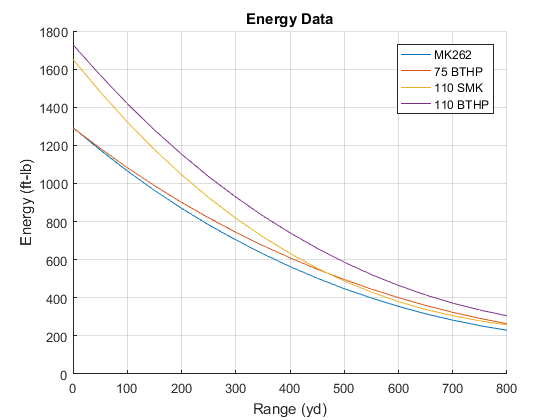
The energy plots show the clear advantage of the 6.8 SPC at close range, and to some degree shore up NFA regarding retained energy at range. However, when we adjust the ballistic coefficient of the 110 BTHP, it is clearly superior at range to all the other offerings. The 115 SMK is again demonstrated to be an inferior projectile, dumping most of its energy advantage by 400 yards. But still, with the adjusted BC for the projectile I find that it still carries more energy to 600 yards than the MK262. After 600 yards the 115 SMK likely loses velocity more quickly as it enters the transonic velocity range and its ballistic coefficient will decrease, which is not accounted for in these plots, which assume BC doesn’t change.
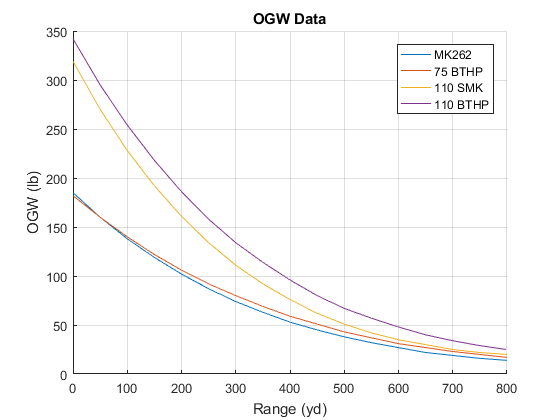
OGW is a commonly used metric, and one must be careful to use it to compare ballistics between similarly powered cartridges, similar caliber projectiles, and bullet construction and purpose. All of the above rounds listed in the above chart are spritzer boat tail jacketed projectiles and so are reasonably comparable for performance against similar targets. In this case the OGW is a useful metric and like energy shows the clear superiority of the 6.8 SPC over the two .223 caliber cartridges against which it is compared. By 500 yards the 115 SMK has given up all advantage but the 110 BTHP continues to be the superior cartridge at least to 650 to 700 yards, the point where the round reaches the transonic region of flight where the ballistic coefficient will decrease.
Returning to NFA claim that the 6.8 SPC is limited to form factors of 1.15, we consider the 110 AB and 120 SST, and add them to the comparison above. I recently measured the muzzle velocity of MK262, Hornady 120 SST, and Nosler 110 Accubond ammunition, all from 18″ Bison Armory barrels. The following data adds the performance of the new rounds for comparison. The 120 SST starts out the heaviest and slowest of the bunch at 2540fps but with an i7 form factor of 1.077. The 110 Accubond was able to push 2600fps and has the best i7 form factor of the 6.8mm projectiles at 1.073.
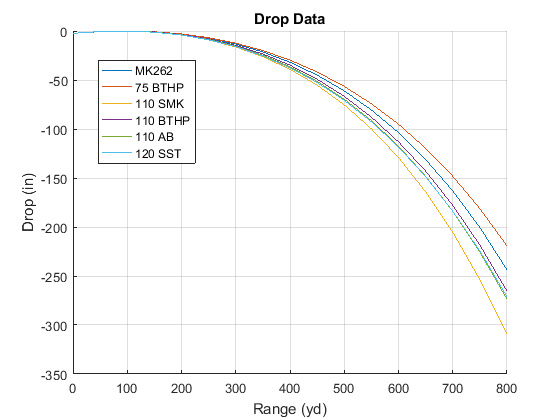
In terms of drop, the .224 caliber projectiles cannot be matched, and the 110 BTHP is still the best contender in the 6.8mm group, though the 120 SST and 110 Accubond keep up nicely. The 115 SMK drops like a rock.
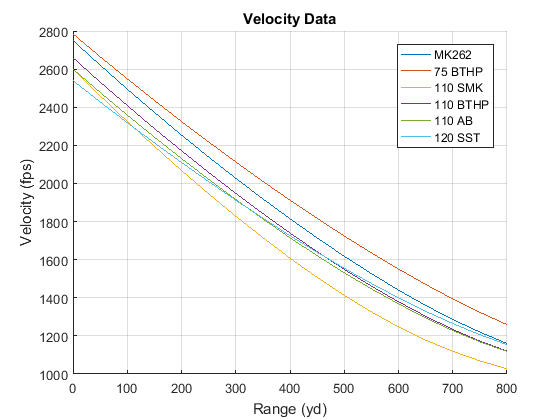
Velocity shows another story. Though the 75 BTHP is an outstanding projectile, the 120 SST nearly catches up to the MK262 and its 77 grain SMK by the beginning of the transonic region at 700 yards. The 110 Accubond starts out slower but effectively equals the 110 BTHP by 400 yards thanks to its low i7 form factor. The 115 SMK is left in the dust and again we see it is only suited for short range plinking and target use under 600 yards.

At short range, the energy of the 6.8mm SPC is in a different league than the 5.56 NATO offerings even with their modern relatively high power loadings. The 115 SMK really is a lousy bullet. The 120 SST is the superior cartridge/bullet combination, and if loaded as hot as the MK262 would outclass all comers by additional margin. The 110 Accubond and 110 BTHP could also be loaded in this way. We know from above that bolt thrust will increase, yet we have already mocked that concern and do not need to beat a dead horse. 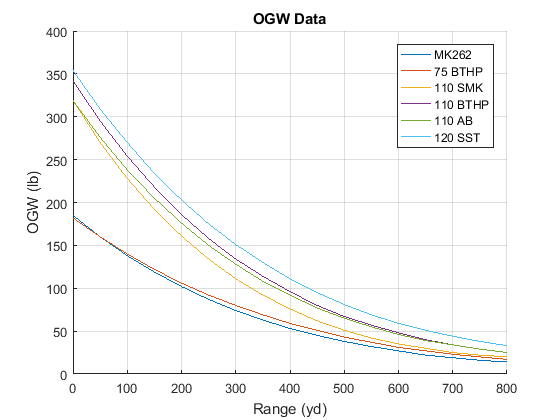
Considering OGW is effective again because the 110 Accubond and 120 SST are designed for hunting and as such the comparison above is conservative and shows the 110 Accubond equaling the 110 BTHP, while the 120 SST outmatches all comers. Considering bullet design in the mix puts the 110 Accubond above the 110 BTHP.
My treatment is terse, and for non-writers it is challenging to produce a quality article for anyone interested to read. I’m guessing Nathaniel F thought the same thing and so we can forgive the shortcomings of his interesting article that provides many good points for discussion. I think I have demonstrated that the 6.8 SPC has some distinct advantages compared with the 5.56 NATO when loaded to modern specifications, much the way the 5.56 NATO improves with modern propellants and superior projectiles.
Taking the 224 Valkyrie 80 grain SMK to 1000 Yards
Thursday presented a great opportunity to run the 80 grain Sierra MatchKing 224 Valkyrie load from Washougal River Cartridge to 1000 yards. Muzzle velocity for this round is about 2850+ fps from a 24″ barrel. Combine that with a G1 BC of 0.461 and the round is supersonic past 1100 yards. In a 20″ barrel at 2780 fps the bullet is still supersonic past 1050 yards. Numbers are fine but we have to get ready to shoot. The 224 Valkyrie wasn’t the only rifle we brought, of course. I’m getting the 6.5 Creedmoor ready first:
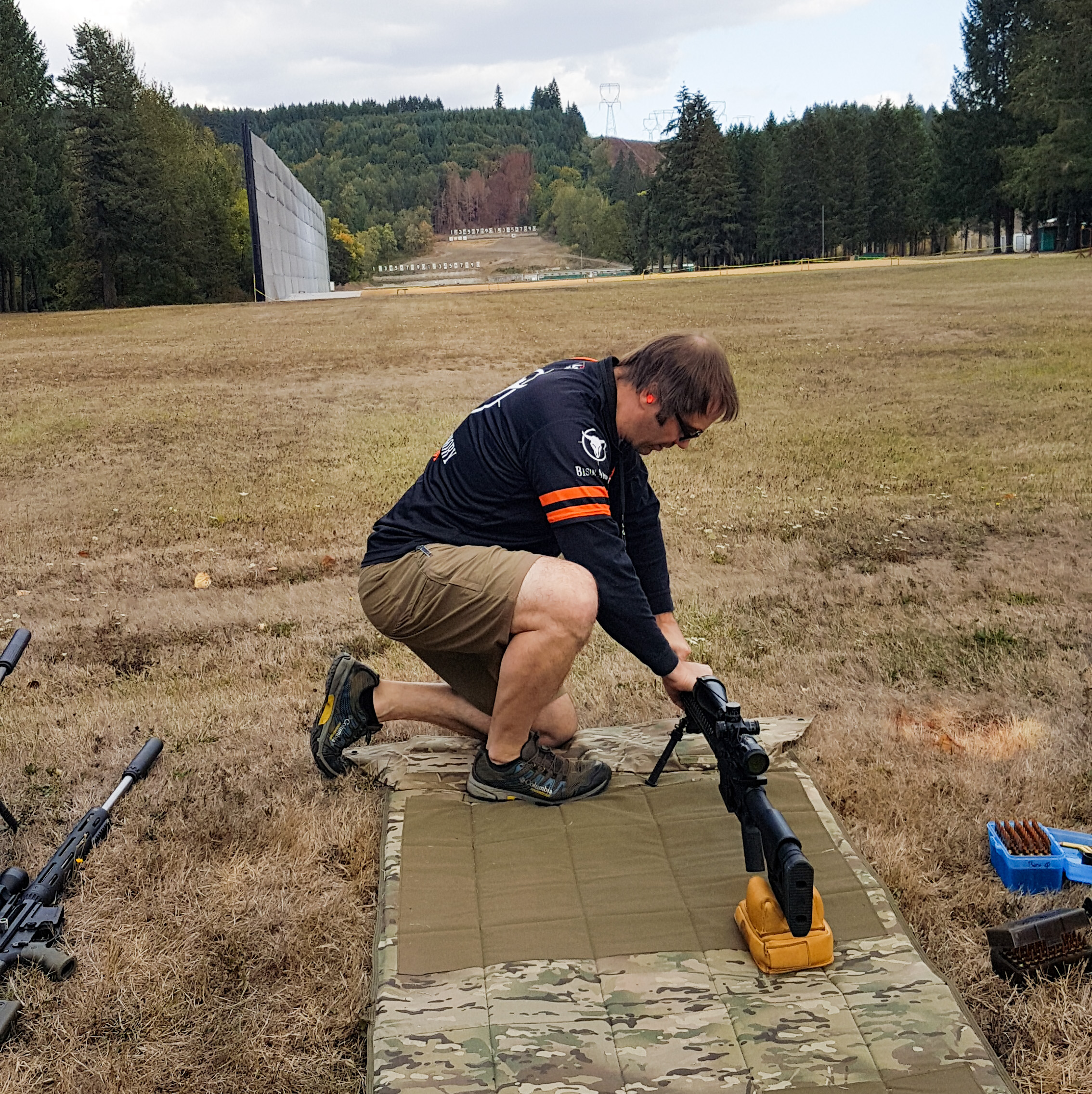
Turns out you really do need that extra 20 MOA in the scope mount to hit the target at 1000 yards. The ADM mount pictured above doesn’t have it and I ran out of elevation getting on target. Needed to hold the bottom of the reticle on the center of the target to get on paper. My wife likes my homeless guy hairstyle, I cannot understand why. Must be the bald spot.
My 224 Valkyrie with our 24″ Bison Armory heavy barrel was up next. The Bobro mount has 20 MOA of elevation built in, and the Leupold Mark 6 scope is up to the task:
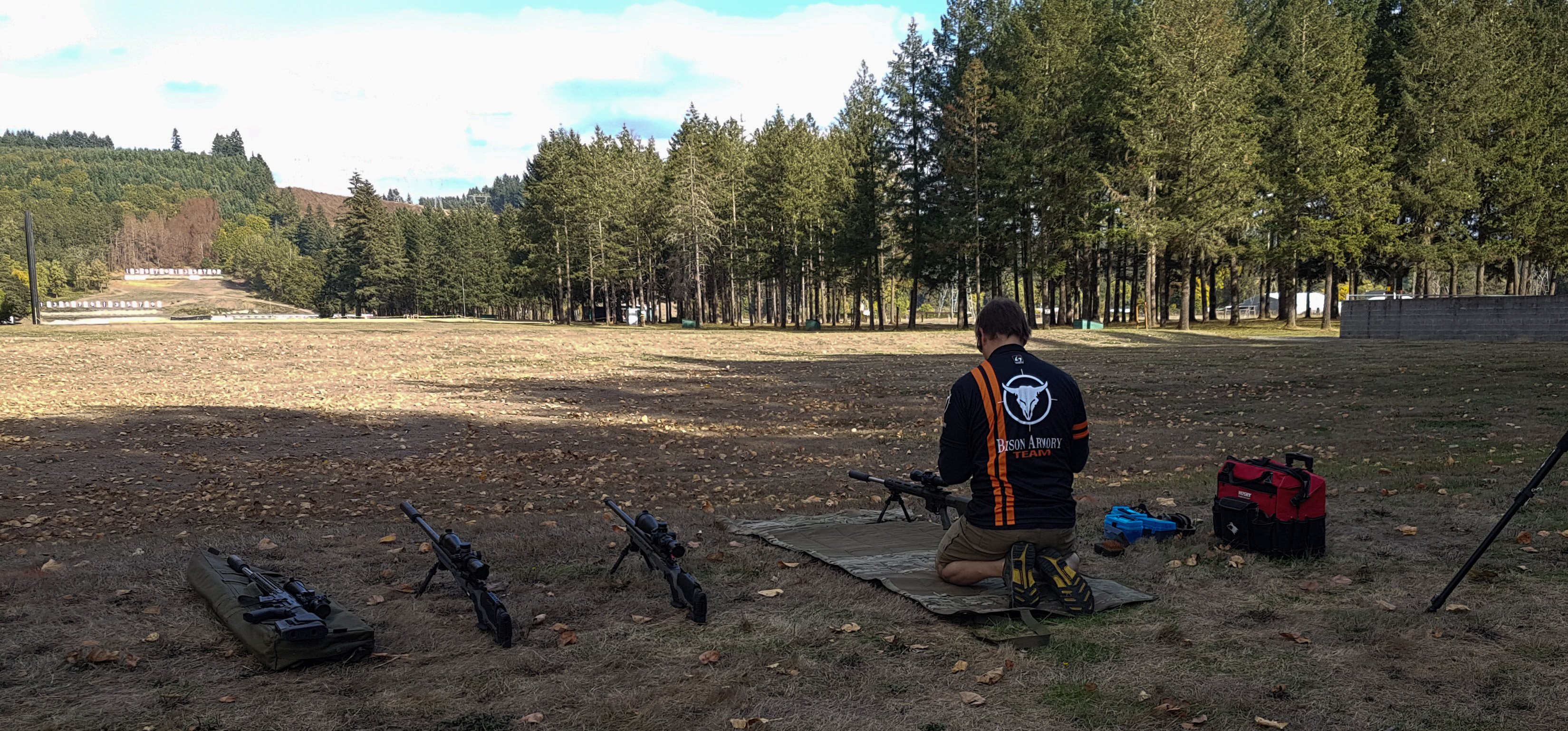
We brought a pair of .260 Rem bolt guns too. They weigh in around 22 pounds each, and that substantial mass makes it easy to stay on target. Here’s your humble Bison Armory proprietor putting rounds down range with the Valk:
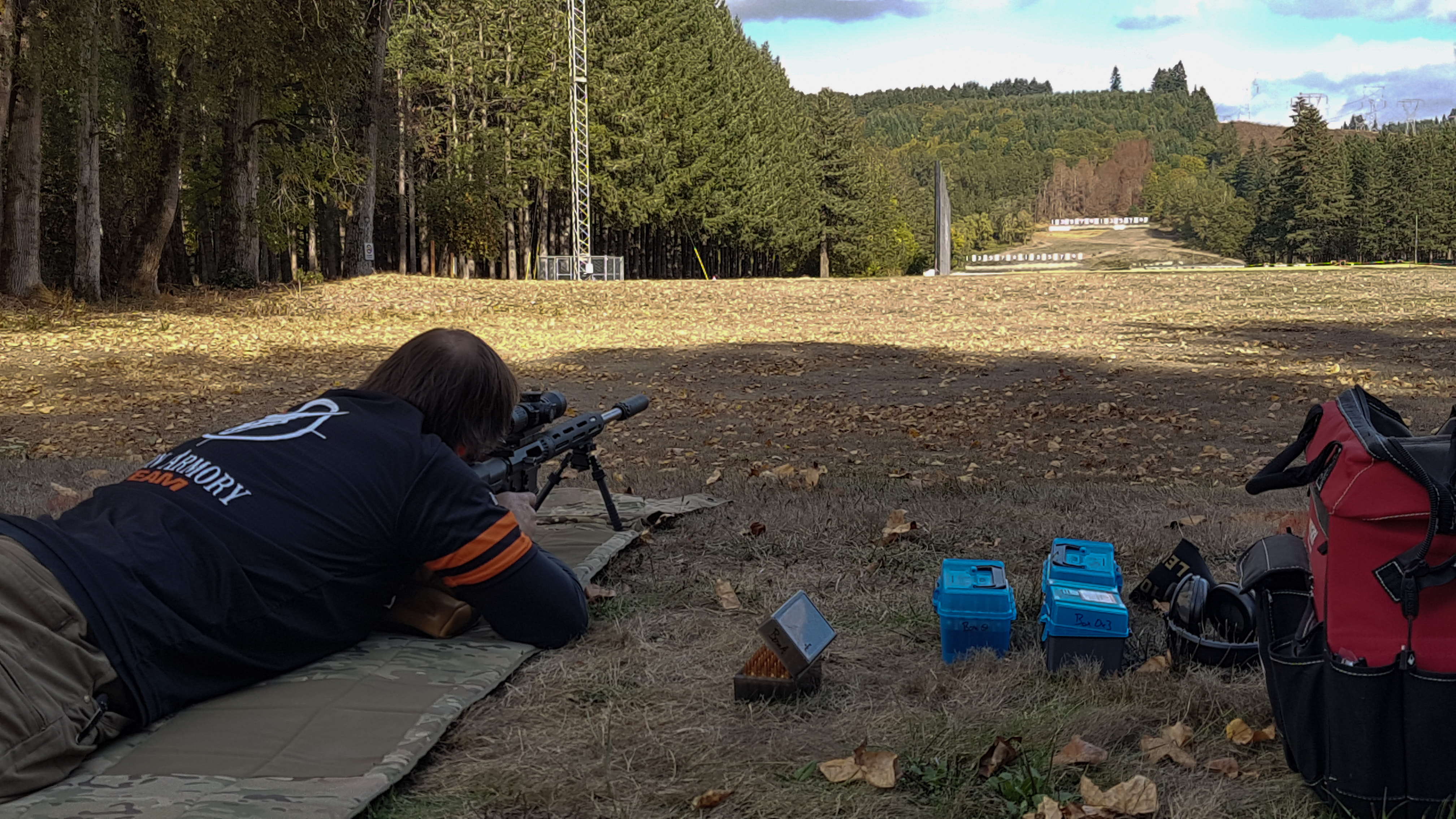
I am perpetually grateful to have Douglas Ridge and their 1000 yard range available on Thursdays. I’m also grateful that the 80 SMK shoots superbly at 1000 yards. I shot these two 6-shot groups, about 10 minutes apart under changing conditions. I didn’t adjust my scope, but you can see how a small change in the wind can put your rounds in a different spot on paper:
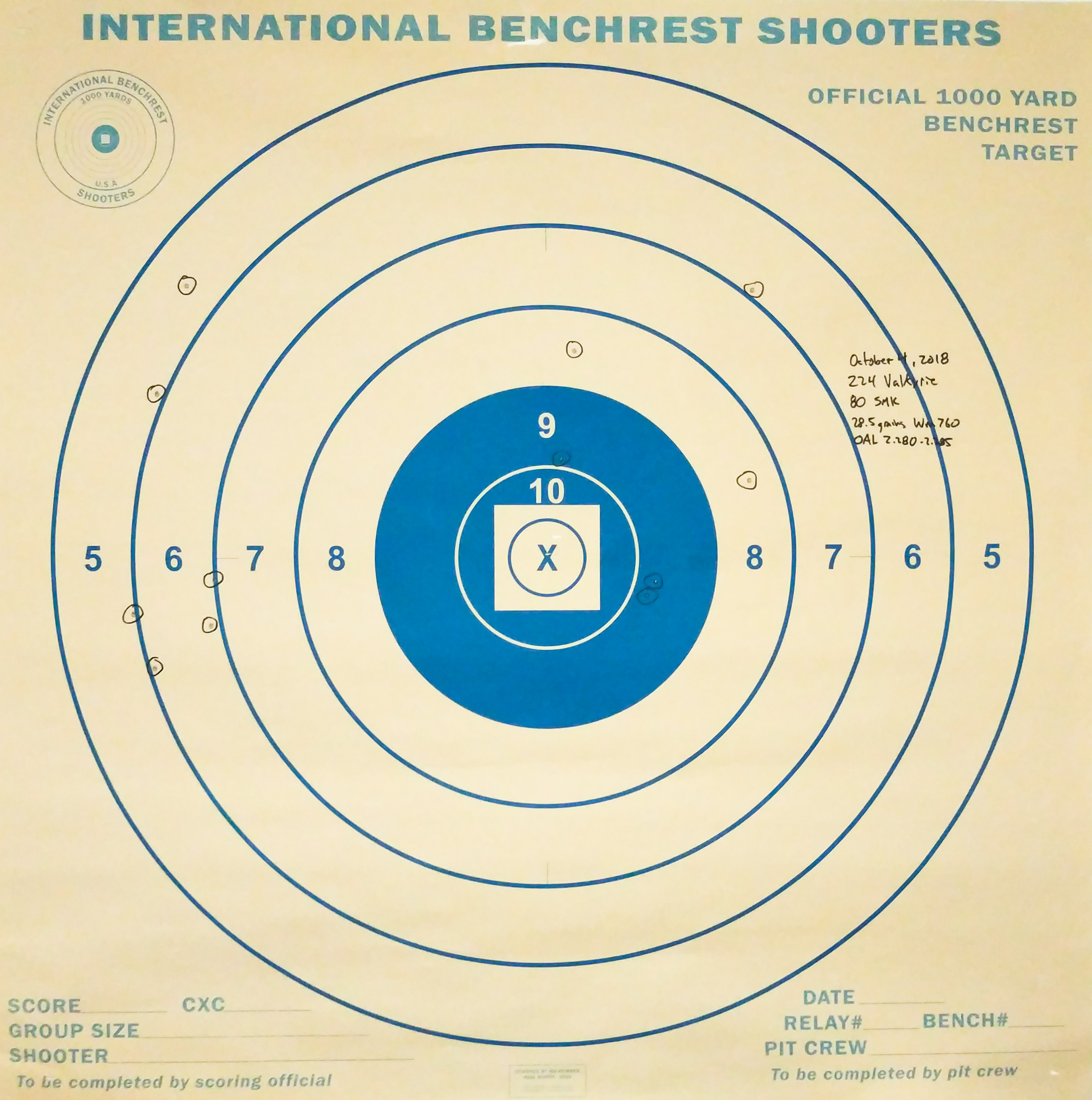
I am not the best shot and I’m easily able to hold 5 shots into one minute of angle and 6 shots close to that. Shooting at longer ranges is providing that extra challenge that 100 yards doesn’t have. The conditions I’m shooting in are challenging and these are just 5 mph winds. One of these days I’m going to show up with significant winds and getting the right windage will be challenging and a lot of fun. The low recoil makes working on your follow through a snap:
This ammunition is match quality, and you can get it on the Bison Armory web store, along with our 1:6.5 twist 224 Valkyrie barrels at www.bisonarmory.com/store
1000 Yards with the .224 Valkyrie
I took the .224 Valkyrie out to the 1000 yard line on Thursday at Douglas Ridge Rifle Club in Oregon. It’s about time I got to stretch the Valk’s legs. I was shooting the 95 SMK in a Bison 24″ 1:6.5″ twist barrel. My muzzle device was an Elite Iron brake that I normally use with their Bravo 1 silencer but my DOPE for my previous sight in was taken without the silencer so I kept it like that for this session. Here’s the view from the targets looking back at the firing position:
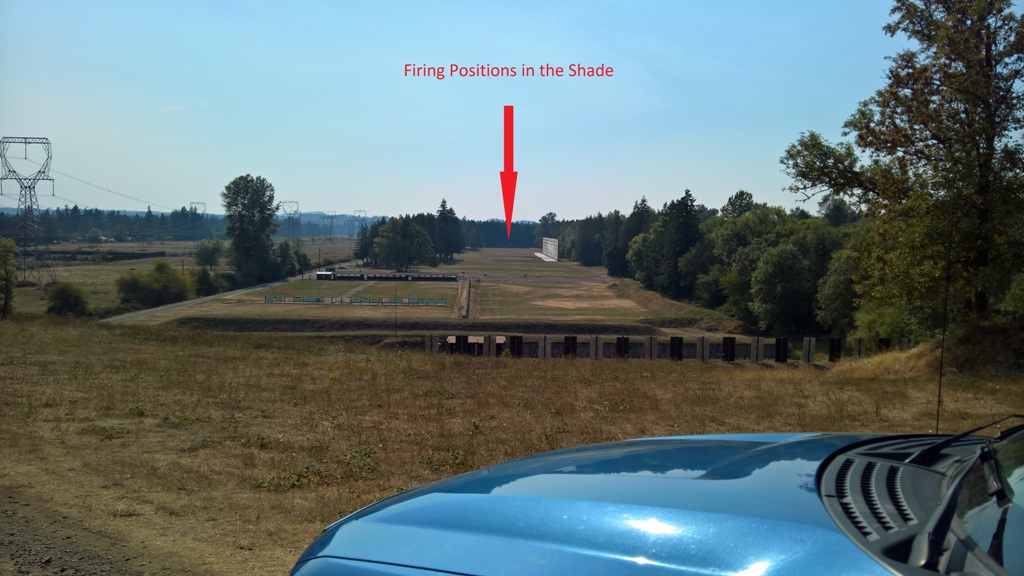
The target positions are behind me. The targets in front are for 200 to 600 yard service rifle competitions. Here’s the view from the 900 yard firing line:
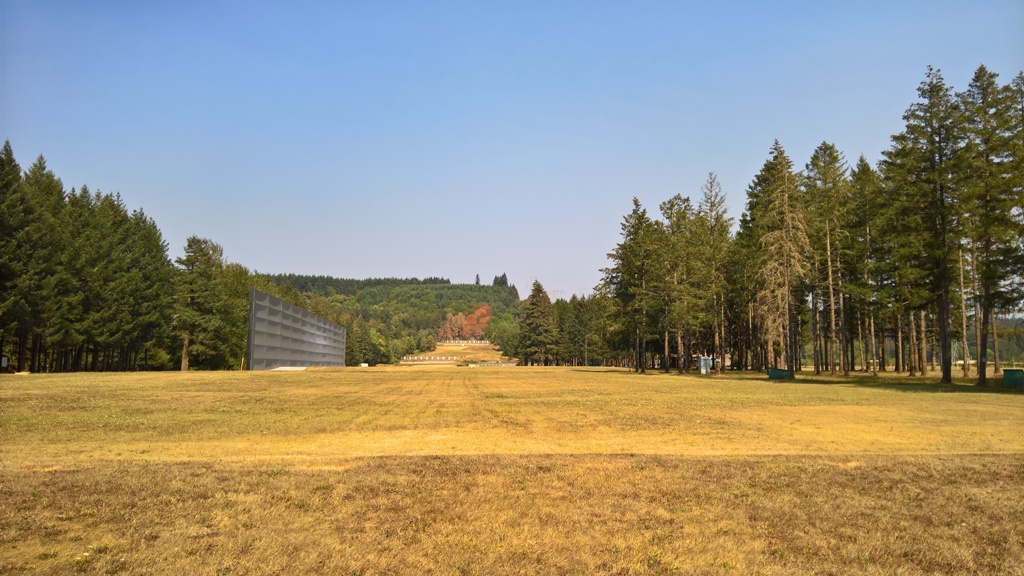
Turns out it helps to get on paper to know which firing line you are at. I thought I was at the 800 yard line and I ended up wasting quite a bit of ammo getting on paper. Checking against my DOPE and ballistics data I was quite puzzled at the almost 7.8 mils of come up needed to get on paper when I had computed something more like 6.8 mils were needed. Thanks to the low recoil of the .224 Valkyrie I was able to see the rounds hitting the dirt which told me I was a ways off. Wasting ammo with my bald spot blasted by the late afternoon sun wasn’t my idea of fun. But I did get on paper and then back to the 1000 yards line we go. Shade is a good place to shoot from.
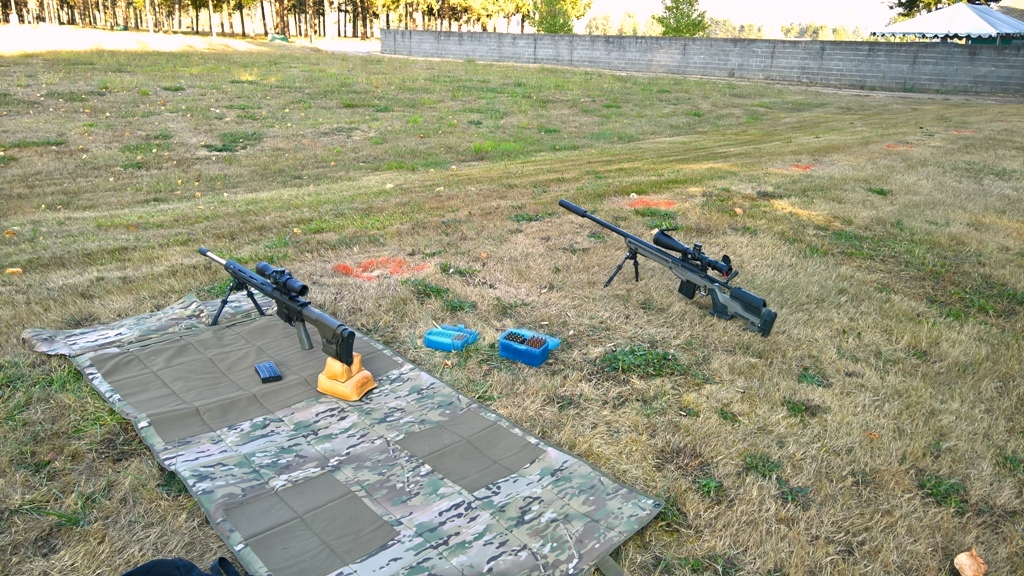
The .260 Rem got to try 1000 yards too. The DOPE for that one was way off as well, you’d think that would have told me something. I got on paper and then changed targets. I should have taken a photo of the Caldwell Target Camera LR system that I was using. This thing was the best $350 I’ve spent in a while.
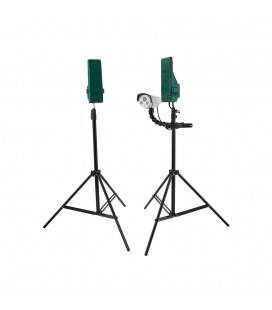 I have no Android or iOS devices So I had to improvise. You can log into the camera through a website. The IP address of the camera is marked on the side, which in my case is 192.168.0.3, and then provide the username admin with the password 12345 and you get to a menu written in Chinese. Selecting the second item in the menu gets you to the live feed from the camera.
I have no Android or iOS devices So I had to improvise. You can log into the camera through a website. The IP address of the camera is marked on the side, which in my case is 192.168.0.3, and then provide the username admin with the password 12345 and you get to a menu written in Chinese. Selecting the second item in the menu gets you to the live feed from the camera.
A note about this system: I couldn’t see a single hole in the target black though I hit it several times. Hits in the white are clearly visible. I recommend using these targets for 1000 yard shooting with the Caldwell Target Vision camera system:
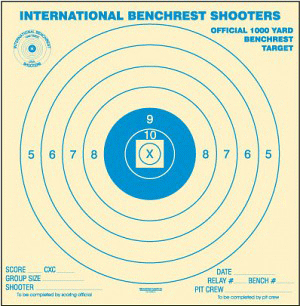
I haven’t used this target yet but I think it will work well. It’s 42″ square and I think light enough to see the bullet strikes. I was using white cardboard which worked really well too, but didn’t cover the target black behind it completely so it I could not make out the bullet holes that were not in the white. I’ll report back after my next session later this month about how the IBS targets worked out.
As one might guess, getting on paper at 1000 yards given my confusion about which line I was shooting from at 900 yards, a little work was needed to get on paper at 1000 yards. Again puzzling because once on paper my come up was 9.2 mils when I had expected 10 mils from my ballistics computations and then probably more given the 7.8 mils I thought I needed at what I thought was 800 yards. Both the .260 Rem and the .224 Valkyrie were consistently inside 12″, which is pretty good for me given that I’d never shot at this distance before. Winds were consistently inconsistent but at about 5 mph. The direction changed often and sometimes died out completely only to come back again 30 seconds later. First time out at 1000 yards, the range all to myself, what’s not to like:

Holy mackerel, my nose isn’t nearly that big in real life, I swear! Now that I’m dialed in, I’ll be shooting some groups my next outing instead of just spraying all over the target while constantly adjusting my windage and elevation. Conclusion: .224 Valkyrie can shoot at 1000 yards. Next time: 80 SMK loaded to about 2850 fps in the 24″ barrel. Oh yeah, after wrapping up for the day I noticed that the 800 and 1000 yard berms were really close together. That’s when the dam broke and I realized I’d been shooting at 900 and not 800, argh!
.224 Valkyrie 95 SMK
I finally got to test some 95 SMK hand loads. I used Winchester small rifle primers, new Federal brass, and Winchester 760 powder starting at 26.0 grains and working up to 27.5 grains. The rifle has a 24″ 1:6.5″ twist Bison Armory heavy barrel and an Elite Iron muzzle brake but I left off the silencer and shot unsupressed for the testing.
I only shot a single 5-shot group at each charge and got the following average velocities with standard deviation below 13 for all and extreme spread no greater than 27:
26.0: 2430 fps
26.5: 2510 fps
27.0: 2555 fps
27.5: did not measure, estimate 2600 fps
I shot the first three loads at 100 yards and shot a near 1/2″ group with the 26.5 grain load:
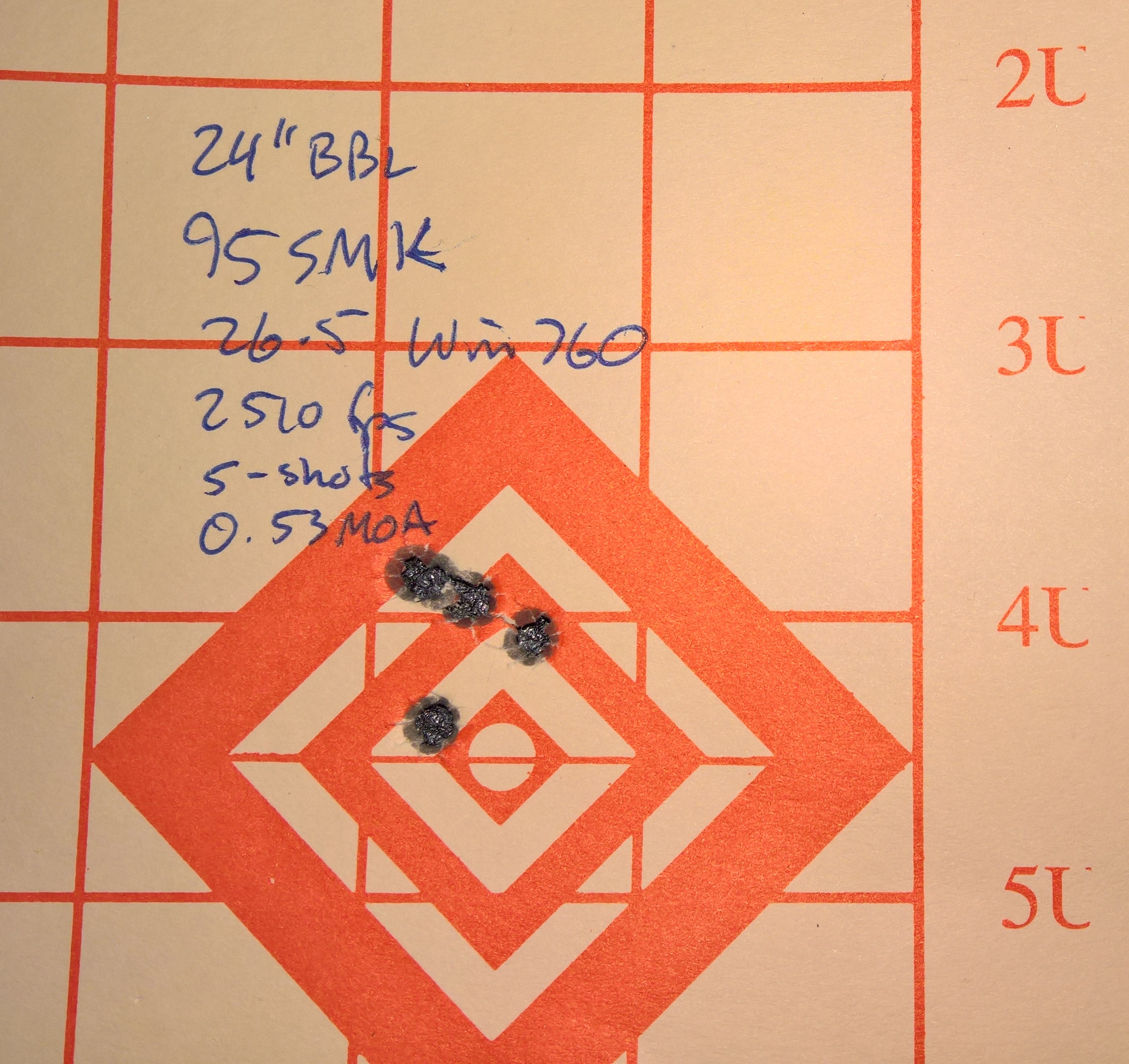
2510 fps at the muzzle with a G1 BC of 0.60 results in 1318 fps at 1000 yards and 1168 fps at 1200 yards. The speed of sound is around 1130 fps and this load stays above that to 1250 yards according to the G1 BC and available data. The load is definitely a 1000 yard performer in terms of velocity. Hopefully I will get to shoot it at 1000 yards this summer. Pushing to 2550 or even 2600 fps seems reasonable, though accuracy wasn’t quite as good as I pushed the bullet faster. Single 5-shot groups are not sufficient to make a firm determination but more testing is in order.
I am thinking that Federal’s 90 SMK accuracy troubles may result from loads that are just too hot. I wonder if they’re pushing the bullets too hard to get the mythical 1300 yard supersonic performance but sacrificing accuracy. Seems like a lousy trade to me when solid 1000+ yard performance from a 75 to 95 grain bullets is great performance from any AR-15 rifle.
.224 Valkryie 80 Grain SMK Match
New .224 Valkyrie ammo brought to you by Bison Armory. We’ve teamed up with the Washougal River Cartridge Company to produce match grade .224 Valkyrie ammunition specifically designed for 1:7 twist barrels. Using Starline brass and pushing the 80 grain Sierra Matchking bullet to 2780 fps from a 20″ Bison Armory barrel, we’re getting excellent accuracy and keeping the bullet supersonic to 1100 yards. Available early May 2018, pre-order now!
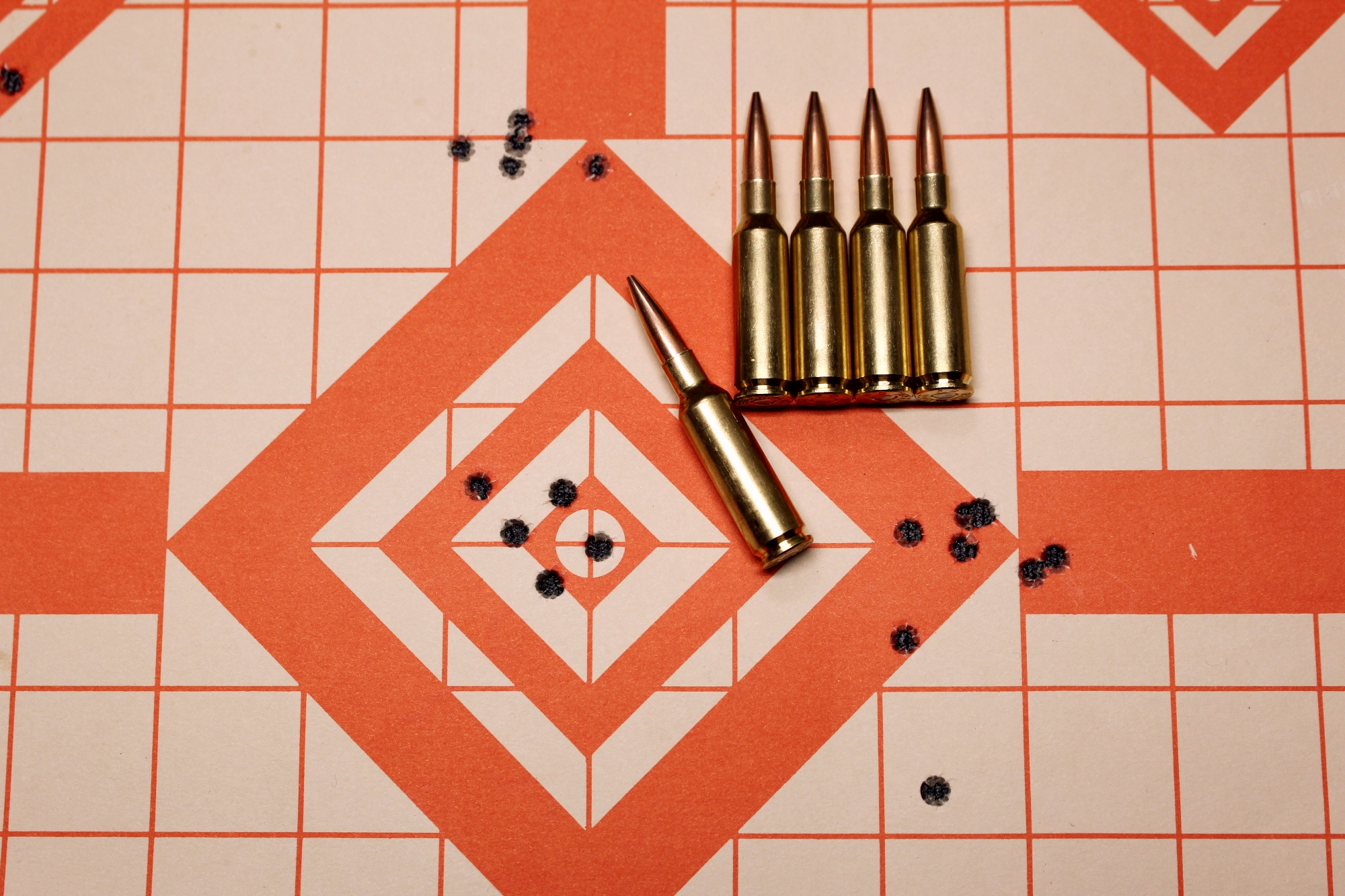
Youth / Low Recoil Hunting Rifles Part 2
In part 1 of this post last week I looked at recoil and report, as well as muzzle velocity when comparing a typical 20″ .243 Win hunting rifle with a 16″ 6.8 SPC AR-15. Both of these rifles are mild recoiling and excellent for youth hunters, or really any hunter who wants an easy to carry rifle for medium game like deer, black bears, cougars, and hogs. The results shown in the last post indicate that the .243 has the edge in recoil and velocity for 95 grain bullets, though the 6.8 SPC will be a little easier on the ears. In keeping the 6.8 SPC to 16″ barrel length, the addition of a silencer, typically adding 5 to 7 inches of length to the weapon, will be easier to carrier and shoulder than the 20″ .243 Win.
We turn our attention to the down range performance of the two rounds. Since the last post, I’ve learned that Barnes isn’t making the 95 grain .243 caliber TSX anymore so I’ve replaced it with the 95 grain Hornady SST, so all the analysis of the previous posts for internal ballistics is the same. The G1 BC of that bullet is .355, while for the 95 grain 6.8mm TTSX the G1 BC is .292 and the 110 Accubond has a G1 BC of .370.
| Muzzle velocity (fps) | 300 yard velocity (fps) | 400 yard velocity (fps) | 300 yard drop (inches) | 400 yard drop (inches) | |
|---|---|---|---|---|---|
| .243 Win 95gr Hornady SST BC .355 | 2834 | 2108 | 1893 | 12.9 | 30.4 |
| 6.8 SPC 95gr TTSX BC .292 | 2707 | 1865 | 1627 | 15.8 | 37.7 |
| 6.8 SPC 110gr Accubond BC .370 | 2531 | 1878 | 1687 | 17.2 | 39.8 |
The table shows that the .243 Win shoots flat. Most youth will keep shots on deer well under 300 yards, but I’ve used 300 as a good benchmark as that’s a shot you want to be able to make. The 6.8 SPC shooting both the 95 and 110 grain bullets is no slouch and both the .243 and 6.8 will be able to hit game at 300 and 400 yards. How do these rounds stack up in terms of energy?
| 100 yard energy (ft-lb) | 200 yard energy (ft-lb) | 300 yard energy (ft-lb) | 400 yard energy (ft-lb) | |
|---|---|---|---|---|
| .243 Win 95gr Hornady SST | 1402 | 1152 | 938 | 756 |
| 6.8 SPC 95gr TTSX | 1221 | 953 | 734 | 558 |
| 6.8 SPC 110gr Accubond | 1293 | 1060 | 862 | 695 |
| 6.8 SPC 110gr Accubond 20" barrel 2600 fps | 1368 | 1124 | 916 | 741 |
Again, the .243 Win has the edge over the 6.8 SPC, though the 6.8 hangs in there with the 110 grain Accubond, and either of these calibers will take medium size big game out to 300+ yards. Note that in a 20″ barrel where the 110 Accubond can push to 2600+ fps, the energy of the round has effectively caught up to the .243 Win. The tradeoff then is terminal performance vs overall length of rifle. A 16″ AR-15 is very ergonomic and easy for a hunter, especially a youth hunter, to carry and shoulder in the field. The addition of a silencer to the 16″ weapon isn’t as cumbersome as when added to a 20″ weapon.
However you compare them, the .243 Win and the 6.8 SPC both make excellent choices for mild recoiling hunting rifles for medium sized game. Personal preference for energy down range, flat trajectory, rifle size and weight, report sound level, and those intangible aspects like personal preference for a given caliber, are all valid reasons to choose .243 Win or 6.8 SPC. There are of course many other calibers, like the 6.5 Grendel and .300 Blackout in AR-15 platforms, and .260 Rem, 6.5 Creedmoor, and .25-06, etc. in bolt action platforms, that make for great mild recoiling hunting rifles. One thing is for certain, hunting is a great American tradition and pastime, and there is no lack of choices when it comes to rifle calibers that get the job done.
Youth / Low Recoil Hunting Rifles Part 1
Updated June 24, 2017
The 6.8 SPC caliber makes for great medium sized game hunting from hogs to deer to black bears and more. The 6.8 has mild recoil, and a lightweight rifle chambered in this caliber is ideal for hunts in which you put a lot of miles on your feet, up and down in hilly terrain. The mild recoil is preferred for anybody, but especially so for young hunters, women hunters, or anyone who wants a lightweight easy shooting rifle. My 18″ 6.8 is what I choose when I’m hunting deer in central and eastern Washington State. I’m not considering the ultra-mild recoiling .223 because it’s not legal for big game hunting in many states, my home state of Washington included.
The standard youth deer rifle appears to be a bolt action .243 Winchester with a 20″ barrel. I’ve never shot one but I’m told it has mild recoil, which I find surprising given that the .243 Win is based on a .308 parent case. My goal with this post is to compare the 6.8 SPC to the .243 Win. I want to compare external ballistics, recoil, and report / sound level – as every good parent wants to protect their child’s hearing as much as possible. Using QuickLoad as the tool for internal ballistics, and Hornady’s external ballistics calculator for down range performance, we can compare performance against several metrics.
Recoil
For most of us dad’s out there, we want our kids to have fun hunting and shooting. We start them young, and the last thing we want is a flincher because we started them with too much gun. Turns out the 6.8 SPC and .243 Win are great choices for youth hunters and shooters in terms of recoil. To see why we can compare the recoil force due to the impulse imparted by shooting on the rifle and shooter. The entire process of powder ignition to bullet exit at the muzzle takes about 1 millisecond. The force imparted to the rifle can be estimated from the impulse based on the following formula:
![]()
which is the impulse due to a constant or average force, ![]() , applied over a timespan starting at
, applied over a timespan starting at ![]() and ending at
and ending at ![]() . An impulse is a change in momentum so we can also compute the impulse
. An impulse is a change in momentum so we can also compute the impulse ![]() as
as
![]()
where ![]() is the starting velocity and
is the starting velocity and ![]() is the end velocity, and m is the mass that we assume does not change for this analysis. From the previous two equations we can make the following equation:
is the end velocity, and m is the mass that we assume does not change for this analysis. From the previous two equations we can make the following equation:
![]()
And then we solve for the average force that would result from the given impulse
![]()
which, given that ![]() and
and ![]() , and letting
, and letting ![]() , the total time from ignition to uncorking, simplifies to
, the total time from ignition to uncorking, simplifies to
![]()
Report
The magnitude of the report is primarily due to the sound pressure at the muzzle the moment the bullet exits. The ratio of pressures is captured by this expression (using the reference pressure ![]() which is regarded as the smallest sound pressure change the human ear can detect):
which is regarded as the smallest sound pressure change the human ear can detect):
![]()
This is the sound pressure right at the muzzle, which would instantly destroy anyone’s hearing if their ear was right at the muzzle. At a distance of 1m the sound drops considerably
![]()
We’ll take ![]() as the distance at the muzzle and 1m at the shooter to avoid taking the log of zero to get numbers that are typical of rifle report measurements.
as the distance at the muzzle and 1m at the shooter to avoid taking the log of zero to get numbers that are typical of rifle report measurements.
Now we are armed to compare recoil between the 6.8 SPC and .243 Win, and for added fun we’ll throw in the .223 Rem and .308 Win to see how they both stack up to a high power round. To get a true apples to apples comparison for recoil, we’ll assume 16″ barrels for internal ballistics. When we look at external ballistics, I’ll leave the 6.8 SPC at 16″ and use the more common 20″ barrel for the .243 Win and .308 Win, and an 18″ barrel for the .223. These barrel lengths will also be used for comparing the report from the rifles. Especially great for comparison, the 6.8 SPC and .243 Win have shoot similar weight projectiles. In this case we’ll compare the 6.8mm 95 grain Barnes TTSX against the .243 95 grain Barnes TSX. Using Quickload with similar near max safe pressures we find the following:
| Rifle/Bullet | .243 Win 95 gr TSX 20" | 6.8 SPC 95 gr TTSX 16" | 6.8 SPC 110 gr AB 16" | .308 Win 165 gr AB 20" | .223 Rem 75 gr SMK 18" |
|---|---|---|---|---|---|
| Velocity (ft/s) | 2831 | 2707 | 2530 | 2630 | 2700 |
| Time to Exit (ms) | 1.08 | 0.802 | 0.877 | 1.165 | 0.88 |
| Exit Pressure (psi) | 16076 | 10390 | 9880 | 9809 | 11152 |
| F-average (lbf) | 1160 | 1420 | 1406 | 1846 | 937.7 |
| Report (dB) | 144.4 | 140.6 | 140.2 | 139.4 | 141.2 |
Note that the values for the report in the table are estimates, but useful for relative comparison. Barrel length is representative of typical youth hunting rifle barrels. As the barrel length increases, so does the muzzle velocity, and the report at the shooter decreases as the exit pressure is lower and the point of exit of the bullet is further from the shooter.
As we all know, the recoil from a .223 Rem is very mild and this data agrees. The .308 has significantly more recoil, and the .243 and 6.8 are relatively mild, with the .243 being almost as tame as the .223. From a recoil point of view, either would do but the .243 is best for typical hunting calibers. Muzzle velocity is also the best for a 20″ .243 Win, though the report is the worst of the bunch. Lesson – wear hearing protection when you hunt.
Speaking of hearing protection, a silencer is best, or electronic ear muffs. The 16″ 6.8 combined with a compact silencer makes a great gun, decreases recoil further, and isn’t so long as to be uncomfortable for an American youth to carry in the field. My oldest son has been hunting deer with a 16″ 6.8 AR-15 with an Ops-Inc silencer since he was 11 years old.
In the next post I’ll compare the external ballistics of the 6.8 SPC and .243 Win.
June 2 2017 Range Time
Took 4 rifles to the range on Friday:
18″ 308 Fulcrum
18″ 223 Fulcrum
18″ 6.8 Recon
22″ 6.8 Heavy
Except for the 223, all shooting was with hand loads. Today’s post relays the results of 20 rounds of 308. The rifle was wearing a Vortex PST, decent but nothing fancy.
18″ 308 Fulcrum Results
My version of the 168 SMK FGMM
Load 1:
168 SMK over 42 grains of H4895
Federal cases, CCI large rifle primers
OAL 2.80″
MV 2577fps
Result: 10 shot group at 100 yards
Sigma = 0.249MOA (0.183 to 0.358 – 95% confidence)
Extreme Spread = 0.82 MOA
P1-0.5 = 91.8% (72 to 99% – 95% confidence)
P1-1.0 = 100% (99 to 100% – 95% confidence)
Pretty good. Indicates high probability that 7/10 shots are expected to be within 0.5MOA of true point of aim, and 10/10 shots should be within 1.0MOA of target. For an auto loader this is great.
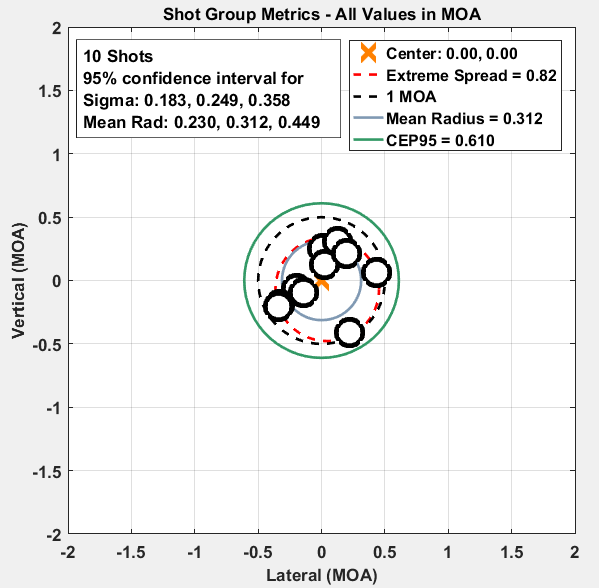
Load 2:
168 SMK over 43 grains of H4895
Federal cases, CCI large rifle primers
OAL 2.80″
MV 2611fps
Note: First shot was 2″ below the center of the rest of the group. I’m calling this an outlier, but I don’t like it.
Result: 9 shot group at 100 yards
Sigma = 0.389MOA (0.281 to 0.547 – 95% confidence)
Extreme Spread = 1.69 MOA
P1-0.5 = 66.9% (35.2 to 86% – 95% confidence)
P1-1.0 = 97.7% (79.5 to 100% – 95% confidence)
Not as good as the last group, and my shooting ability is an uncertain factor. Still, this data indicates high probability that 3.5/10 shots are expected to be within 0.5MOA of true point of aim, and 8/10 shots should be within 1.0MOA of target. So the question is: did my shooting fall apart and produce this less precise group, did the additional 1 grain of gunpowder cause the degradation, some combination of the two, or something else?
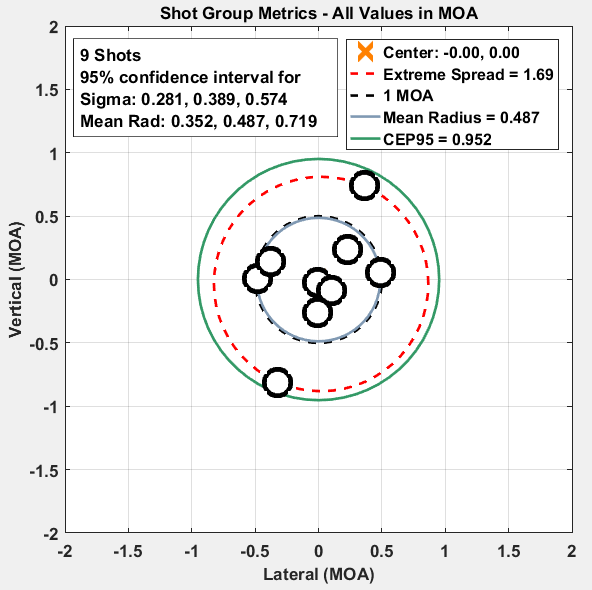
For fun we can combine the two groups by overlaying at the “center of mass” of each group
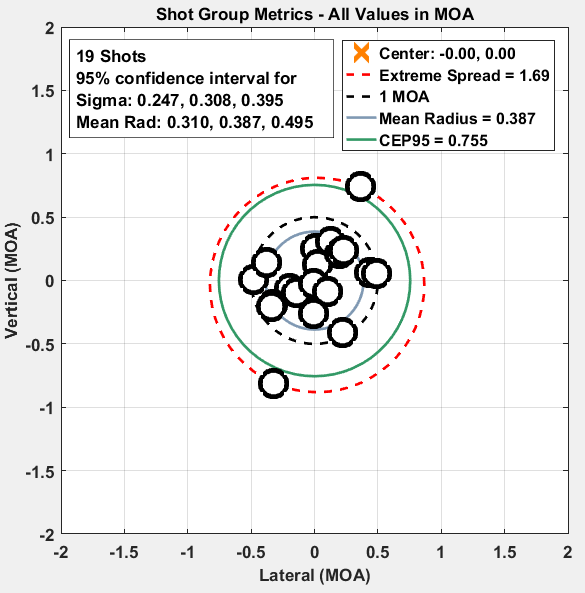
There is clearly a cluster in the middle and then two outliers. I’ll never know the cause but this is interesting. To get more insight, separating the groups by coloring them differently shows the contribution to the blob above from each (ignore the numbers, they’re for a single group):
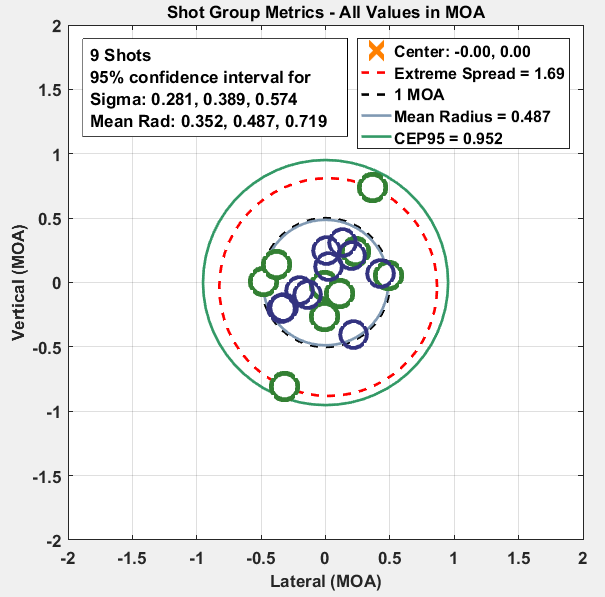
The 17 rounds clustered in the middle imply something… the rifle is clearly capable of excellent accuracy for an auto-loading weapon. Did those two shots come from bad shooting? Bad loading? Fatigue? Are they truly representative of the weapon itself?
Possible I wasn’t as careful with the second batch of 10 rounds as I was with the first while charging the cases or seating the bullets. Or I was tired as this was later in the day after shooting the other rifles. And what was with that shot that was 2″ low? Clearly, more range time is warranted.
I’ll get to those other rifles in the next post.